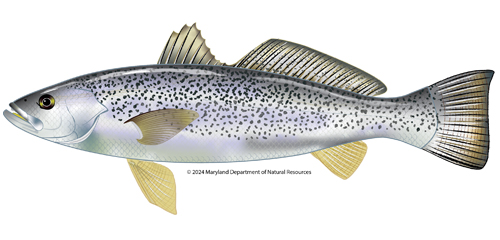| Weakfish |  |
Weakfish | | Cynoscion regalis | (A.K.A. - Gray trout, Squeteague, Sea trout, Tiderunner, Drummer)
| Key Distinguishing Markings:
- Body greenish grey above and silvery below.
- Back with small spots forming undulating dotted lines.
- Pelvic fins and anal fin yellowish.
- Other fins pale, sometimes with a yellowish tinge.
- Inside of gill cover (dark, visible externally).
- Mouth large, oblique, lower jaw projecting.
- Upper jaw with a pair of large canine-like teeth at tip.
- Chin without barbels or pores. Snout with only 1 marginal pore.
- Gas bladder with a pair of nearly straight, horn-like appendages.
- Soft portion of dorsal fin covered with small scales up to 1/2 of fin height.
- Weakfish are members of the drum family, Sciaenidae; other familiar members of this family include spot, Atlantic croaker, black drum, channel bass, and spotted seatrout.
- Fishes of this family produce a drumming or croaking sound by contracting special muscles around the swim bladder. Note: The East Carolina University (ECU) Sciaenid Acoustics Research Team has identified at least two types of weakfish sounds. Males make a purring sound by drumming their swim bladders and an aggregation of spawning weakfish can sound like static.
View the Weakfish Gallery
| Distribution:
- Found along the Atlantic coast from Nova Scotia to Florida, they are most abundant from New York to North Carolina.
- During summer, they are largely located north of North Carolina in nearshore marine and estuarine waters.
- Larger weakfish may range from Delaware into New England while smaller weakfish are located more to the south.
- With decreasing water temperatures in late fall, adults leave the estuaries and begin a southerly, offshore migration to the continental shelf between Chesapeake Bay and Cape Lookout, North Carolina.
- Weakfish are found in Maryland's offshore waters, throughout the coastal bays, and in Chesapeake Bay.
- Adult weakfish are most frequently encountered along the coast within ten miles of shore, in and around the Ocean City inlet, and in the southern reaches of Chesapeake Bay.
- With increasing water temperatures in the spring, adult weakfish begin to migrate inshore and north from their wintering grounds to nearshore estuaries, bays, and sounds.
- Larger fish (age two and older) enter lower Chesapeake Bay in April-May, with fish age one becoming abundant in summer.
| Size:
- Weakfish may grow as large as 29 inches and reach 12 pounds.
| Habitat:
| Spawning:
- Spawning in the region usually occurs shortly after the spring migration, peaking during April-June.
- Peak spawning is during May – September along nearshore areas and mouths of estuaries.
- Fecundity (number of eggs produced) increases as weakfish get larger.
- Fecundity cannot be exactly determined because eggs are continuously produced and released in batches throughout the March-October spawning season.
- About 90% of weakfish become mature after their first year and all reach maturity by the second year.
Peak larval abundance in Chesapeake Bay usually occurs during late summer, and larvae are generally distributed throughout the lower Bay, with the highest densities near the Bay mouth and along the eastern Bay margin.
- Larvae move from the water column to the bottom when they reach 0.3 inches.
- Juveniles are usually abundant during mid-summer through mid-fall. Growth is rapid during their first year and they reach an average length of about 7 inches by the end of the growing season.
- Juveniles are very common in Maryland's coastal bays. The largest concentrations in Chesapeake Bay usually occur south of Choptank River.
- Weakfish may live as long as 17 years, but 12 years would be a more reasonable expectation of maximum lifespan.
| Fishing Tips:
- Weakfish catches are at an all-time low.
- A preponderance of evidence indicates that a substantial rise in natural mortality that started in the mid-1990s largely caused weakfish biomass and size structure to decline greatly by 2003.
- Insufficient forage, especially Atlantic menhaden, and increased predation by striped bass have emerged from these analyses as leading contributors to rising natural mortality.
- Maryland has a small to moderate recreational fishery, accounting for 2-29% of all weakfish landed along the Atlantic Coast.
- Our commercial fishery is much smaller in comparison and our landings comprise less than 5% of the coastal total.
- For current recreational size and creel limits, see Maryland's updated regulation page.
| Fun Fact:
- This fish's name, "weakfish", refers to the tender, easily-torn membrane of the fish's mouth, rather than its fighting ability.
- The age of a weakfish is determined by counting growth rings on their otoliths (ear bones).
- The largest weakfish ever recorded was caught in 1989 in Delaware Bay and measured 30 inches in length and weighed 19 pounds, 2 ounces.
- The Bay size record weighed 19 pounds and was taken at the Chesapeake Bay Bridge Tunnel in 1983.
- The oldest weakfish ever caught was aged at 17 years.
| | Family: Sciaenidae (Drums or croakers) | | Order: Perciformes (perch-likes) | | Class: Actinopterygii (ray-finned fishes) | For more information on weakfish and their management; please check the ASMFC website www.ASMFC.org (look for weakfish in the Managed Species section) or contact Jim Uphoff.
Illustration by Kevin Ensor,
Maryland Department of Natural Resources,
Fishing and Boating Services |
|
